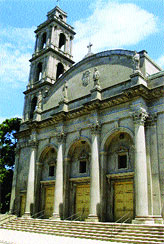 |
 |
|||||
 |
 |
 |
 |
 |
|||
 St. Gelasius Church in Woodlawn helped spark the controversy. Catholic New World/ Sandy Bertog |
Landmarking stalls
Council faces challenges from religious groups By Michelle Martin Staff writer Religious leaders from all denominations have joined in the campaign to oppose changes to Chicago’s landmark law that would allow the city to designate houses of worship as landmarks without the consent of their owners. “We feel it’s an inappropriate intrusion into religious decision-making,” said the Rev. Paul Rutgers, executive director of the Council of Religious Leaders of Metropolitan Chicago. “It basically puts a control on both the present and future of any property so designated.” At issue is a clause in the municipal code that exempts any building “owned by a religious organization and … used primarily as place for the conduct of religious ceremonies” from being designated a historical landmark without the consent of the owner. Ald. Burton Natarus (42nd Ward) proposed repealing that clause, which would allow the city to make churches landmarks. Landmarked buildings cannot be taken down or changed—even repaired—except with the approval of the city, which can designate the materials used and the design of any changes to keep the building’s historical integrity. Rutgers and several dozen other religious leaders attended an April 27 meeting of the Chicago City Council’s Committee on Historical Landmark Preservation at which Natarus amended his proposal so that the landmark status would apply only to the exterior of religious buildings. However, the matter was not called for testimony or a vote. “When and if they call it again, we will be there with at least that many and more,” said Rutgers, a Presbyterian minister. The issue is not preservation, he said. “I don’t know any congregation that does not want to maintain their buildings,” he said, suggesting that city officials sit down with religious leaders to find ways to help religious communities preserve historic edifices. But by giving buildings landmark status, the city would make it impossible for some congregations to sell or maintain their buildings. “Our mission is not to maintain buildings as museums, it is to witness to God and to serve people,” he said. “It is ironic indeed that at the time the faith communities are being asked to contribute more to the well-being of the city—and rightfully, we should be—this kind of serious burden should be placed on the religious community.” The issue came to a head when St. Gelasius Church in Woodlawn was slated for demolition after it closed in 2002. After the city stopped a permit to take the closed church down, the archdiocese announced plans for the Institute of Christ the King to come in and use the building. Preservationists have called on religious groups, including the Archdiocese of Chicago, not to tear down buildings no longer being used for religious purposes, insisting they be maintained, despite the high cost of retaining an unused structure when money is short. While that case drew attention to the issue of landmarking religious buildings, the religious leaders’ campaign is not just about Catholic churches or about tearing religious buildings down, but about changing their use, Rutgers said. “It potentially makes it impossible to do what religious communities frequently find the need to do, which is to make changes to their buildings so they can worship in the present rather than in the past,” he said. “We have black Christian congregations worshipping in facilities that once were synagogues, we have Muslim communities worshipping in buildings that once were part of the archdiocese.” To do that, Rutgers said, the new faith communities must find ways to make the buildings reflect their own traditions, thus changing their facades. So far, more than 40 religious leaders, including Cardinal George, have signed a letter to Mayor Richard M. Daley protesting the proposed change, and the council is asking its members to contact their aldermen, Rutgers said. |
||
|
|
|||